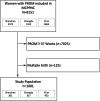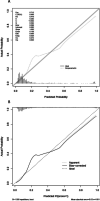Predicting risk of severe neonatal outcomes in preterm infants born from mother with prelabor rupture of membranes
- PMID: 35787798
- PMCID: PMC9252037
- DOI: 10.1186/s12884-022-04855-0
Predicting risk of severe neonatal outcomes in preterm infants born from mother with prelabor rupture of membranes
Abstract
Background: Perinatal complications are common burdens for neonates born from mother with pPROM. Physicians and parents sometimes need to make critical decisions about neonatal care with short- and long-term implications on infant's health and families and it is important to predict severe neonatal outcomes with high accuracy.
Methods: The study was based on our prospective study on 1001 preterm infants born from mother with pPROM from August 1, 2017, to March 31, 2018 in three hospitals in China. Multivariable logistic regression analysis was applied to build a predicting model incorporating obstetric and neonatal characteristics available within the first day of NICU admission. We used enhanced bootstrap resampling for internal validation.
Results: One thousand one-hundred pregnancies with PROM at preterm with a single fetus were included in our study. SNO was diagnosed in 180 (17.98%) neonates. On multivariate analysis of the primary cohort, independent factors for SNO were respiratory support on the first day,, surfactant on day 1, and birth weight, which were selected into the nomogram. The model displayed good discrimination with a C-index of 0.838 (95%CI, 0.802-0.874) and good calibration performance. High C-index value of 0.835 could still be reached in the internal validation and the calibration curve showed good agreement. Decision curve analysis showed if the threshold is > 15%, using our model would achieve higher net benefit than model with birthweight as the only one predictor.
Conclusion: Variables available on the first day in NICU including respiratory support on the first day, the use of surfactant on the first day and birthweight could be used to predict the risk of SNO in infants born from mother with pPROM with good discrimination and calibration performance.
Keywords: Preterm prelabor rupture of membranes; Prognostic nomogram; Severe neonatal outcomes.
© 2022. The Author(s).
Conflict of interest statement
All authors contributed to review and revision, and have seen and approved the final version of the manuscript. The authors have no conflicts of interests to declare.
Figures




Similar articles
-
Birthweight and Apgar at 5 minutes of life for the prediction of severe neonatal outcomes in preterm prelabor rupture of membranes.J Matern Fetal Neonatal Med. 2022 Dec;35(23):4521-4525. doi: 10.1080/14767058.2020.1854214. Epub 2020 Dec 1. J Matern Fetal Neonatal Med. 2022. PMID: 33403889
-
Effect of obesity on neonatal outcomes in pregnancies with preterm premature rupture of membranes.Am J Obstet Gynecol. 2016 Feb;214(2):287.e1-287.e5. doi: 10.1016/j.ajog.2015.09.093. Epub 2015 Oct 3. Am J Obstet Gynecol. 2016. PMID: 26435047
-
Parents' experiences of transition when their infants are discharged from the Neonatal Intensive Care Unit: a systematic review protocol.JBI Database System Rev Implement Rep. 2015 Oct;13(10):123-32. doi: 10.11124/jbisrir-2015-2287. JBI Database System Rev Implement Rep. 2015. PMID: 26571288
-
Perinatal outcomes of pregnancies complicated by preterm premature rupture of the membranes before 34 weeks of gestation in a tertiary center in China: A retrospective review.Biosci Trends. 2015 Feb;9(1):35-41. doi: 10.5582/bst.2014.01058. Biosci Trends. 2015. PMID: 25787907 Review.
-
Perinatal care at the limit of viability between 22 and 26 completed weeks of gestation in Switzerland. 2011 revision of the Swiss recommendations.Swiss Med Wkly. 2011 Oct 18;141:w13280. doi: 10.4414/smw.2011.13280. eCollection 2011. Swiss Med Wkly. 2011. PMID: 22009720 Review.
References
-
- Committee on Practice B-O ACOG practice bulletin no 188: prelabor rupture of membranes. Obstet Gynecol. 2018;131(1):e1–e14. - PubMed
-
- Zhuang L, Li ZK, Zhu YF, Ju R, Hua SD, Yu CZ, et al. The correlation between prelabour rupture of the membranes and neonatal infectious diseases, and the evaluation of guideline implementation in China: a multi-centre prospective cohort study. Lancet Reg Health West Pac. 2020;3:100029. - PMC - PubMed
-
- Mercer BM. Preterm premature rupture of the membranes. Obstet Gynecol. 2003;101(1):178–193. - PubMed
-
- Lemons JA, Bauer CR, Oh W, Korones SB, Papile LA, Stoll BJ, Verter J, Temprosa M, Wright LL, Ehrenkranz RA, et al. Very low birth weight outcomes of the National Institute of Child health and human development neonatal research network, January 1995 through December 1996. NICHD Neonatal Res Netw Pediatr. 2001;107(1):E1. - PubMed
MeSH terms
Substances
Supplementary concepts
Grants and funding
LinkOut - more resources
Full Text Sources
Medical

